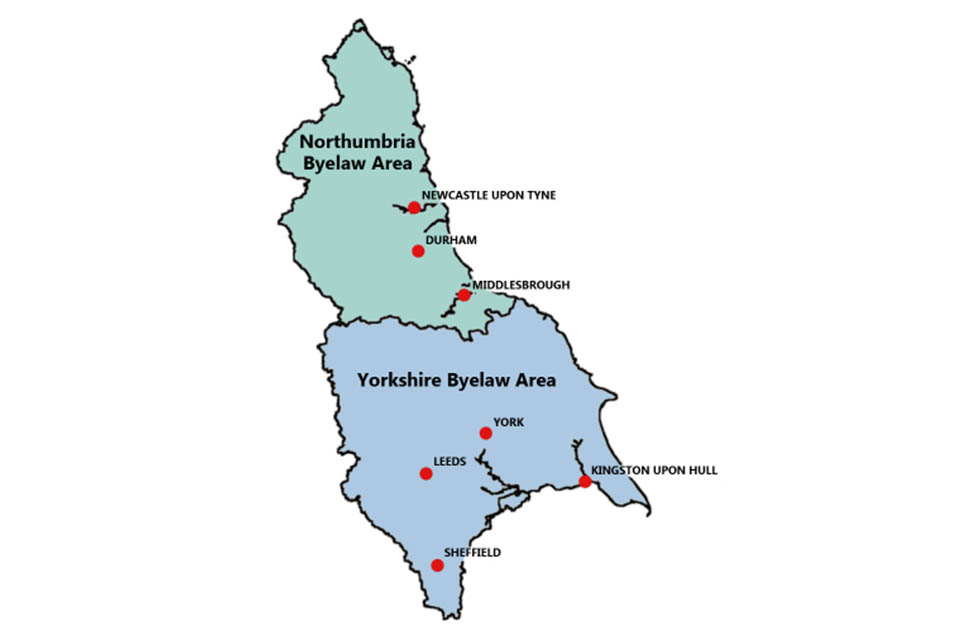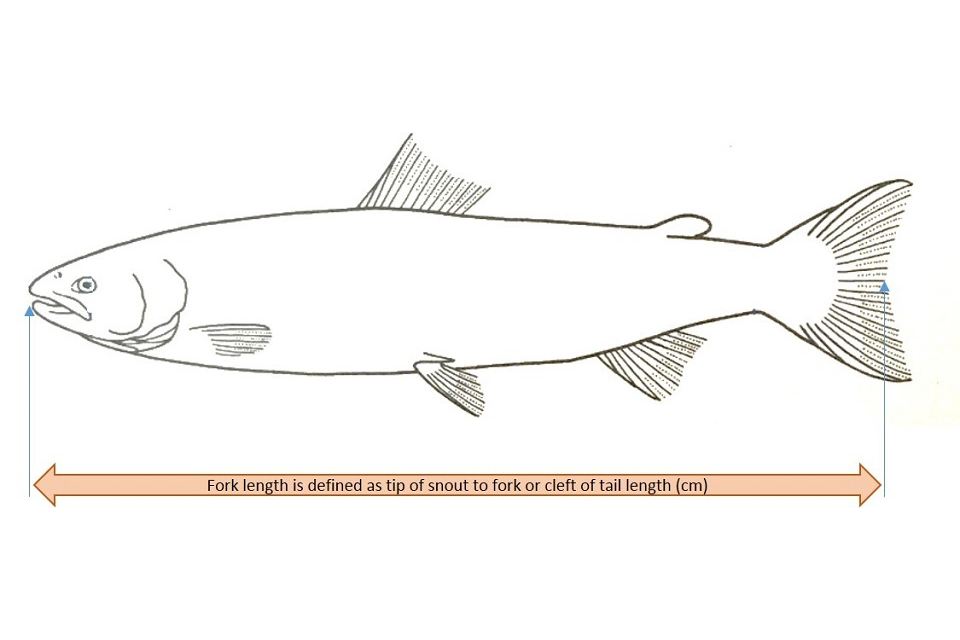Rod fishing byelaws: North East
North East rod fishing byelaws are statutory (regulated by law) rules and regulations explaining who can fish, and where, when and what fish you can take.
Applies to England
North East byelaws overview
North East byelaws apply to anyone fishing with a rod and line for salmon, trout, coarse fish, eels, smelt and lamprey in all freshwater fisheries.
See the national rod fishing byelaws for rules that cover the whole country.
The North East is divided into 2 byelaw areas – Northumbria and Yorkshire.
Northumbria byelaw area
This area covers all waters within river catchments in England that flow into the North Sea northwards from Boulby Craggs, Staithes (near Whitby). It does not include the River Tweed or any of its tributaries.
Principal river catchments include the Tees, Wear, Tyne, Blyth, Wansbeck, Aln and Coquet.
Yorkshire byelaw area
This area covers all waters which drain into, or are within the catchment, of the rivers Swale, Ure, Nidd, Wharfe, Derwent, Hull, Esk, Aire, Calder, Don, Rother and Ouse.
It also includes waters to the north side of the River Humber and all waters which drain directly into the North Sea between Boulby Craggs, Staithes (near Whitby) and Spurn Head.
Rules that apply
Within the North East there are rules that apply:
- across both the Yorkshire and Northumbria byelaw areas
- to the Yorkshire byelaw area only
- to the Northumbria byelaw area only
Angling clubs and private fisheries may enforce their own additional rules, but national and local byelaws still apply.
Map showing the byelaw areas

When and where you can fish
Dates are inclusive
All dates in these byelaws are inclusive. This means a stated period, such as 15 March to 15 June, includes the full day of 15 March and the full day of 15 June.
Coarse fishing close season
There is a coarse fishing close season (when you must not fish) on all rivers, streams and drains from 15 March to 15 June. The Aire and Calder Navigation between Castleford Weir and Ferrybridge lock also has a coarse fishing close season from 15 March to 15 June.
There is no statutory coarse fishing close season on any other canal, reservoir, lake or pond for coarse fish.
Fisheries can impose their own rules to extend the statutory close season, or can impose one if the statutory close season has been removed.
Fishing near weirs, obstructions and at night
You must not fish at any time within a distance of 25m upstream and 95m downstream of:
- Framwellgate Dam on the River Wear
- Ferens Dam on the River Gaunless
- Tees Barrage on the River Tees
- Broken Scar on the River Tees
- Kielder Dam (downstream only) on the River North Tyne
- Ruswarp Weir on the River Esk (downstream side of Ruswarp road bridge)
You must not fish at night, or any time during September, October and November, within a distance of 25m upstream and 95m downstream of:
- Lesbury Weir, Denwick Bottom Dam, Denwick Dam, Cannongate Dam, Filberthaugh Weir and Hulne Park Weir on the River Aln
- Coquet Lodge Dam, Acklington Dam and Felton on the River Coquet
- Humford Dam on the River Blyth
- Bothal Dam, Sheepwash Weir, Morpeth East Mill, Highford Dam and Olives Mill on the River Wansbeck
- Riding Mill Weir, Hexham Bridge Weir, Devils Water Dam, Derwenthaugh Weir, Haltwhistle Weir, Featherstone Weir, Haydon Bridge Weir, Catton Bridge, Whitfield Dam, Chollerford Weir, Otterburn Mill Weir, Tarret Burn, Burnmouth Falls, Mill Falls and Roses Bower Falls on the River Tyne
- Prebends, Chester-le-Street Weir, Burn Hall Weir, Wallnook Dam, Black Ling Hole and Bedburn Gauging Weir on the River Wear
- Burtree Falls on the Killhope Burn, a tributary of the River Wear
- Low Force (Holwick Falls), High Force, Bowes Falls and Bowlees Falls on the River Tees
You must not fish at night within a distance of 25m upstream and 95m downstream of:
- Guyzance Mill on the River Coquet
- Pauperhaugh Bridge on the River Coquet
- Wylam Bridge on the River Tyne
- Dales House Weir on Dale House Beck
You must not fish in rivers, streams and drains for salmon or migratory trout between the end of the first hour after sunset and the beginning of the first hour before sunrise. This is unless the bait you use is a natural or artificial fly and every hook can pass through a tube 10mm in diameter.
Fishing for eel
National byelaws for eel and shad apply in the North East.
Northumbria byelaw area
These byelaws apply on all waters in the North East, from and including the River Tees northwards, but they do not include the River Tweed or any of its tributaries.
Close seasons in Northumbria byelaw area
The close season for:
- salmon is 1 November to 31 January
- sea trout is 1 November to 2 April
- all non-migratory trout on rivers, streams, drains and canals, and for brown trout on all waters other than enclosed stillwaters, is 1 October to 21 March
- brown trout on Crag Lough, Greenlee Lough, Kielder Water, Broomlee Lough, the Derwent Reservoir and East and West Hallington reservoirs is 1 November to 30 April
There is no close season for rainbow trout on any stillwater or for brown trout on enclosed stillwaters.
Yorkshire byelaw area
These byelaws apply on all waters in the North East southwards of (but not including) the River Tees and its tributaries.
Close seasons in Yorkshire byelaw area
The close season for:
- salmon is 1 November to 5 April
- sea trout is 1 November to 2 April
- all non-migratory trout in rivers, streams, drains and canals, and for brown trout in all waters other than enclosed stillwaters, is 1 October to 24 March
There is no close season for rainbow trout in any stillwater, or for brown trout on enclosed stillwaters.
River Esk conservation area
It is against the law to fish with a rod and line for salmon, migratory trout, freshwater fish, smelt, shad or eels on the River Esk between Ruswarp Weir, and a line drawn due west across the river from the southern-most end of Eskside Wharfe in Whitby.

Rods and nets
See the national byelaws for rules about:
- the number of rods you are allowed to use
- using landing nets, keepnets, gaffs or tailers
There are 2 exceptions.
1. Keepnet rule – Yorkshire byelaw area
You must not use keepnets on waters where there is a close season for coarse fish.
2. Foul hooking – Yorkshire byelaw area
You are not allowed to use a rod and line to foul hook any salmon, trout, freshwater fish or eel.
Tackle, lures and baits
National byelaws on lead weights apply in the North East.
National byelaws on using tackle, lures and bait apply in the North East in addition to local byelaws.
You will be committing an offence if you fish for salmon using anything other than an artificial fly or artificial lure before 16 June.
National byelaws on using live bait apply in the North East.
The following 2 local byelaws also apply.
-
On waters where the coarse fish close season applies, during the coarse fish close season you can only use natural or artificial fly, minnow, worm, shrimp, prawn, sand eel and artificial lures.
-
You must not fish in rivers, streams and drains for salmon or migratory trout between the end of the first hour after sunset and the beginning of the first hour before sunrise, unless the bait you use is a natural or artificial fly and each hook does not exceed 10mm in diameter.
Catch limits, size limits, catch returns
National byelaws on catch limits and size returns apply across the North East with the following exceptions.
Salmon
It is illegal to catch and remove any live or dead salmon from these rivers, their tributaries and estuaries:
- Aln, Northumberland
- Belford Burn, Northumberland
- Blyth, Northumberland
- Derwent, Durham and Northumberland
- Don, Tyne and Wear
- Ouse, Yorkshire
- Skelton Beck, North Yorkshire
- Skinningrove Beck, North Yorkshire
- Team, Durham and Tyne and Wear
- Wansbeck, Northumberland
- Waren Burn, Northumberland
You must release all salmon you catch from these waters immediately with the least possible injury.
Northumbria byelaw area size limits
It is illegal to take migratory trout shorter than 25.4cm.
It is illegal to take non-migratory trout shorter than 22.5cm on the:
- River Tees below Egglestone Abbey Bridge
- River Wear below Harelaw Bridge
- River Coquet below Pauperhaugh Bridge
- River Tyne below Hexham Bridge
It is illegal to take non-migratory trout shorter than 17.5cm on the:
- River Tees and tributaries above High Force
- River Lune and tributaries above Selset Reservoir
- River Balder and tributaries above Balderhead Reservoir
- Kilton Beck and tributaries above Lockwood Beck Reservoir
- Burnhope Burn and tributaries above Burnhope Reservoir
- Waskerley Beck and tributaries above Tunstall Reservoir
On any other waters covered by Northumbria area byelaws, it is illegal to take non-migratory trout shorter than 20cm.
Yorkshire byelaw area size limits
It is illegal to take trout shorter than 23cm.
Yorkshire byelaw area catch limits
You must not take more than 6 trout per day without the written consent of the owner or occupier of the fishery.
Day or season tickets sometimes state higher catch limits – you can take this as written consent. You must follow any lower limits on a ticket.
How to measure fish
You measure fish from the tip of the snout to the fork of the tail. You must return undersized fish to the water immediately.

Updates to this page
-
Updated the byelaw for the River Esk conservation area. Updated the type of fish you can fish for and removed the time restrictions in place.
-
We have clarified which areas are covered by these byelaws.
-
First published.